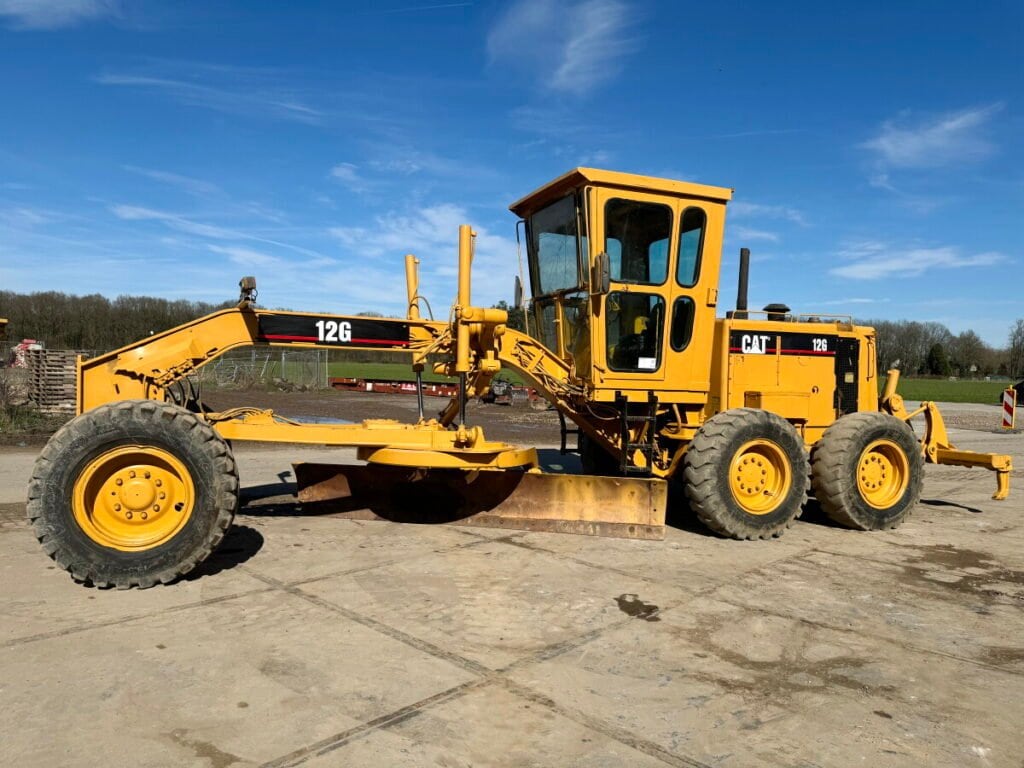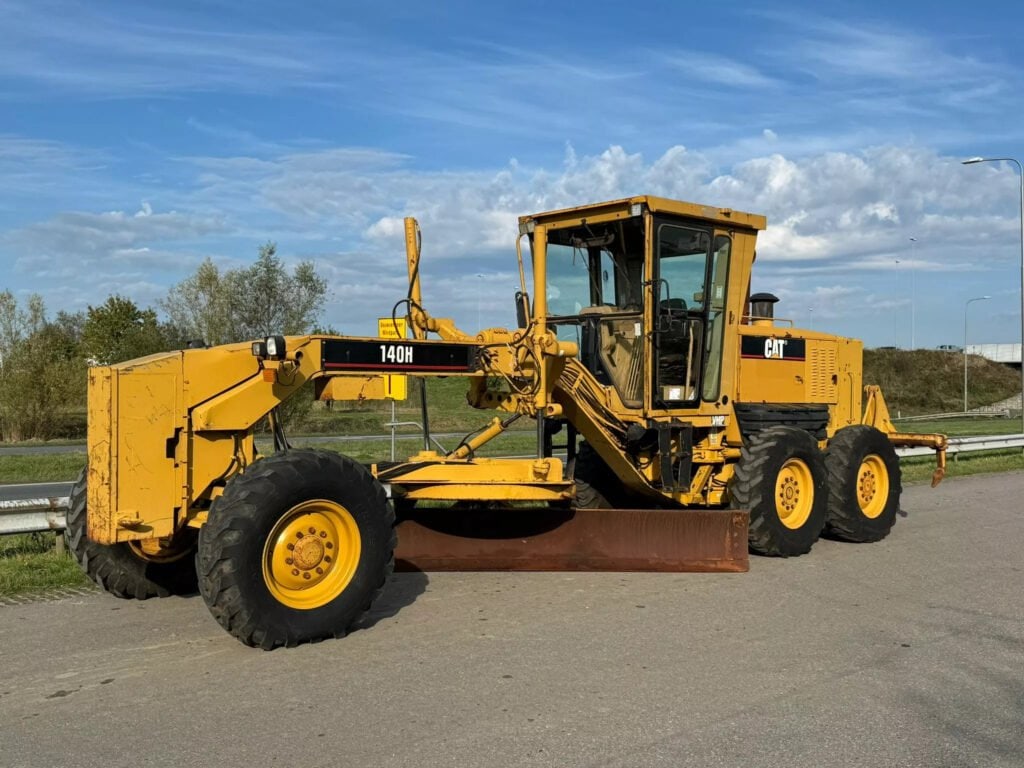Investing in a used motor grader can be an economical choice for your businesses, offering essential grading capabilities at a reduced cost compared to new models. However, it’s crucial for a meticulous used motor grader condition assessment to ensure it provides reliable performance.
Here’s an expanded guide on the Used Motor Grader Condition Assessment, covering all the essential areas you should inspect to make a confident and informed purchasing decision.

1. Inspect the Engine for Performance, Condition, and Efficiency
Overview: The engine determines the power, fuel efficiency, and overall lifespan of a motor grader. A well-maintained engine will allow a grader to operate smoothly across different terrain types, while an engine in poor condition can lead to frequent breakdowns and high repair costs. Assessing the engine’s condition is therefore a priority.
Detailed Engine Checks:
- Visual Inspection: Carefully examine the engine’s exterior for any visible oil leaks, rust, or excessive dirt, which can indicate poor maintenance or potential issues. Look for worn or cracked belts, and check for loose or missing bolts around engine components.
- Startup Performance: Start the engine and listen for any unusual sounds like rattling, knocking, or hissing. Pay attention to the smoke color and density upon startup. Blue smoke may indicate oil burning, which suggests internal wear, while white smoke may indicate cooling issues or a blown head gasket.
- Cooling System: Inspect the radiator for any leaks, and check the coolant level and color. An efficient cooling system prevents overheating, which is critical for heavy-duty operations.
- Engine Hours: Review the total operational hours recorded by the engine, and assess these against maintenance records. An engine with moderate hours that has been serviced regularly may often be more reliable than a low-hour engine with irregular maintenance.
A thorough examination of the engine will provide insight into the machine’s power output, efficiency, and likely future maintenance needs.
2. Evaluate the Hydraulic System for Responsiveness and Leakage
Overview: The hydraulic system is fundamental for operating the blade, attachments, and overall maneuverability of the grader. Issues in the hydraulic system can reduce precision, which affects the grader’s productivity and safety on-site. Therefore, a complete inspection of this system is necessary.
Hydraulic System Inspection:
- Check Hydraulic Lines: Inspect all hydraulic hoses, seals, and connections for any visible signs of leaks or wear. Look for cracks in hoses or fittings, as even minor leaks can lead to larger failures over time.
- Hydraulic Fluid Condition: Assess the fluid for clarity and contamination. Dark, sludgy, or particle-filled fluid indicates possible contamination and poor maintenance, and the fluid may need to be flushed.
- Pump and Cylinders: Operate the grader to test hydraulic functions, such as the blade’s lift and tilt. Listen for any whining or grinding noises, which can indicate issues in the pump or cylinders, and check for smooth operation without jerks or hesitations.
The hydraulic system’s responsiveness and condition are indicators of the grader’s control precision and operational smoothness, impacting efficiency and operator control.

3. Examine the Transmission and Gearbox for Smooth Gear Shifting
Overview: The transmission and gearbox are responsible for adjusting speed and torque, making them crucial for effective grading on varying terrain. A malfunctioning transmission can result in poor maneuverability, increased fuel consumption, and accelerated wear on other components.
Detailed Transmission and Gearbox Checks:
- Operational Testing: While the grader is running, shift through all gears and observe how smoothly the machine transitions. Grinding noises, difficulty shifting, or delays in response could indicate transmission wear or clutch issues.
- Transmission Fluid Inspection: Check the fluid’s color, consistency, and level. Fresh transmission fluid is typically red or light-colored, while burnt or dark fluid may indicate excessive wear.
- Clutch and Torque Converter Functionality: If applicable, test the clutch for response time and make sure the torque converter engages without delay. Sluggish response or unusual noises from these components can indicate internal issues that require further inspection.
A reliable transmission ensures the grader can adapt to various tasks and terrains, maintaining productivity and control during operation.
4. Inspect the Frame, Articulation Points, and Structural Integrity
Overview: The frame and articulation points bear significant stress as they support the machine’s weight and movement. Weakness or wear in these areas can affect the grader’s durability and maneuverability, potentially leading to premature failure or safety issues.
Structural Integrity Assessment:
- Frame Inspection: Carefully examine the frame for any visible cracks, rust, or areas that have been re-welded. These could indicate previous damage from impacts or heavy use, which may compromise long-term stability.
- Articulation Joint Evaluation: Move the grader’s articulation joint to check for smooth movement and ensure there is no excessive play. Loose articulation can lead to less control and reduced precision.
- Corrosion and Rust: Pay attention to any corrosion, especially in areas frequently exposed to the elements. Rust can gradually weaken structural components, so it’s essential to verify the grader has been adequately protected from environmental wear.
A robust and intact structure ensures that the grader will remain stable and perform well, even under demanding conditions.

5. Assess the Moldboard and Cutting Edge for Wear and Capability
Overview: The moldboard and cutting edge are directly responsible for the grading function, so their condition directly impacts grading quality. Worn or damaged moldboards can lead to inefficient operation and may require replacement sooner than expected.
Moldboard and Cutting Edge Inspection:
- Wear Pattern Analysis: Check for any uneven wear on the moldboard, as it could indicate operational misuse or irregular maintenance. Look for cracks, dents, or other signs of heavy wear.
- Cutting Edge Thickness: Inspect the cutting edge for thickness and any signs of severe wear, as a thinned edge will reduce grading efficiency and may need frequent replacement.
- Moldboard Movement: Operate the moldboard’s tilt, rotation, and shift mechanisms to confirm they move smoothly and without excessive effort. Jerky or slow movements may indicate problems with the control system or hydraulic linkages.
The condition of the moldboard and cutting edge will affect grading precision, speed, and material handling, making this inspection essential for effective operation.
6. Examine Tires and Undercarriage for Stability and Traction
Overview: Tires and the undercarriage provide the foundation of the motor grader, affecting stability, traction, and maneuverability on different terrains. Issues with either can reduce the grader’s reliability, especially on rugged or uneven surfaces.
Tire and Undercarriage Inspection:
- Tread Wear Evaluation: Check each tire’s tread depth and look for signs of uneven wear, which may indicate misalignment. Adequate tread depth provides better grip, essential for maintaining control.
- Sidewall Condition: Inspect tire sidewalls for any cuts, bulges, or cracks. Damage in this area can lead to sudden tire failure, which is both a safety risk and a potential downtime factor.
- Undercarriage Condition: Examine components such as the grader’s bolts, guards, and supports. Damaged or worn undercarriage parts can affect balance and increase the risk of further wear and tear.
Maintaining tire and undercarriage quality ensures that the grader maintains traction and stability, especially under challenging conditions.

7. Review the Cabin for Comfort, Visibility, and Safety Features
Overview: Operator comfort and visibility are essential for long shifts, affecting productivity and safety. A comfortable cabin with functional controls allows for precise and responsive operation, while good visibility aids in accident prevention.
Cabin Inspection:
- Control Accessibility and Functionality: Check that all controls, buttons, and displays are easy to reach and respond accurately. Faulty controls can disrupt workflow and decrease grading accuracy.
- Seat Condition and Ergonomics: Ensure the seat is comfortable, adjustable, and free from wear. Operator comfort plays a crucial role in reducing fatigue and improving concentration.
- Safety and Visibility Features: Verify that essential safety features like seat belts, mirrors, lights, and emergency shut-offs are all in working order. These elements ensure the operator’s safety and provide a clear line of sight around the machine.
A well-maintained cabin supports operator productivity and safety, which is especially important for lengthy grading jobs.
8. Analyze Maintenance Records and Previous Usage
Overview: Maintenance records and usage history provide insight into the grader’s overall condition and potential issues. Consistent maintenance and moderate past use are favorable signs, while gaps in service records or heavy use may indicate higher risks.
Records and History Review:
- Routine Service Logs: Look for records of routine maintenance like oil changes, filter replacements, and inspections. A consistent service history indicates a machine that has been well cared for and is likely more reliable.
- Usage History: Determine the types of projects the grader was used for previously. Graders used in rough environments tend to experience faster wear, while those used for light applications may have better longevity.
- Repair Frequency and Pattern: Check if certain components required frequent repairs or replacement, as this could indicate ongoing issues. Identifying potential problem areas will help in assessing future maintenance needs.
By analyzing maintenance and usage history, you gain a clearer understanding of the grader’s reliability and potential for future performance.

خاتمة
Used motor grader condition assessment is a detailed process that involves evaluating each major system, from the engine and hydraulics to the moldboard and transmission. By conducting a thorough inspection and reviewing maintenance records, you can identify a motor grader that meets your operational needs with the reliability and performance required for long-term success.